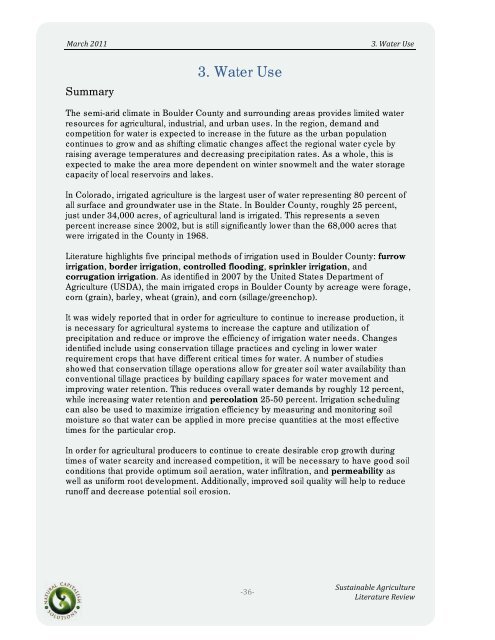Sustainable Agriculture Literature Review - Boulder County
Sustainable Agriculture Literature Review - Boulder County
Sustainable Agriculture Literature Review - Boulder County
You also want an ePaper? Increase the reach of your titles
YUMPU automatically turns print PDFs into web optimized ePapers that Google loves.
! !!<br />
"#$%&!'())!! !!!!!!!!!!!!!!!!!!!!!!!!!!!!!!!!!!!!!!!!!!!!!!!!!!!!!!!!!!!!!!!!!!!!!!!!!?=!@#-2$!A,2!<br />
Summary<br />
!<br />
3. Water Use<br />
The semi-arid climate in <strong>Boulder</strong> <strong>County</strong> and surrounding areas provides limited water<br />
resources for agricultural, industrial, and urban uses. In the region, demand and<br />
competition for water is expected to increase in the future as the urban population<br />
continues to grow and as shifting climatic changes affect the regional water cycle by<br />
raising average temperatures and decreasing precipitation rates. As a whole, this is<br />
expected to make the area more dependent on winter snowmelt and the water storage<br />
capacity of local reservoirs and lakes.<br />
In Colorado, irrigated agriculture is the largest user of water representing 80 percent of<br />
all surface and groundwater use in the State. In <strong>Boulder</strong> <strong>County</strong>, roughly 25 percent,<br />
just under 34,000 acres, of agricultural land is irrigated. This represents a seven<br />
percent increase since 2002, but is still significantly lower than the 68,000 acres that<br />
were irrigated in the <strong>County</strong> in 1968.<br />
<strong>Literature</strong> highlights five principal methods of irrigation used in <strong>Boulder</strong> <strong>County</strong>: furrow<br />
irrigation, border irrigation, controlled flooding, sprinkler irrigation, and<br />
corrugation irrigation. As identified in 2007 by the United States Department of<br />
<strong>Agriculture</strong> (USDA), the main irrigated crops in <strong>Boulder</strong> <strong>County</strong> by acreage were forage,<br />
corn (grain), barley, wheat (grain), and corn (sillage/greenchop).<br />
It was widely reported that in order for agriculture to continue to increase production, it<br />
is necessary for agricultural systems to increase the capture and utilization of<br />
precipitation and reduce or improve the efficiency of irrigation water needs. Changes<br />
identified include using conservation tillage practices and cycling in lower water<br />
requirement crops that have different critical times for water. A number of studies<br />
showed that conservation tillage operations allow for greater soil water availability than<br />
conventional tillage practices by building capillary spaces for water movement and<br />
improving water retention. This reduces overall water demands by roughly 12 percent,<br />
while increasing water retention and percolation 25-50 percent. Irrigation scheduling<br />
can also be used to maximize irrigation efficiency by measuring and monitoring soil<br />
moisture so that water can be applied in more precise quantities at the most effective<br />
times for the particular crop.<br />
In order for agricultural producers to continue to create desirable crop growth during<br />
times of water scarcity and increased competition, it will be necessary to have good soil<br />
conditions that provide optimum soil aeration, water infiltration, and permeability as<br />
well as uniform root development. Additionally, improved soil quality will help to reduce<br />
runoff and decrease potential soil erosion.<br />
"$'"<br />
!*+,-#./#012!34$.%+1-+$2!<br />
5.-2$#-+$2!627.28!
















